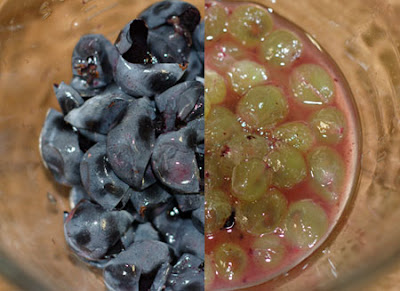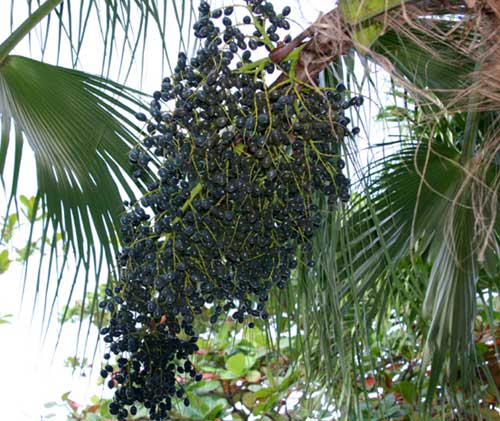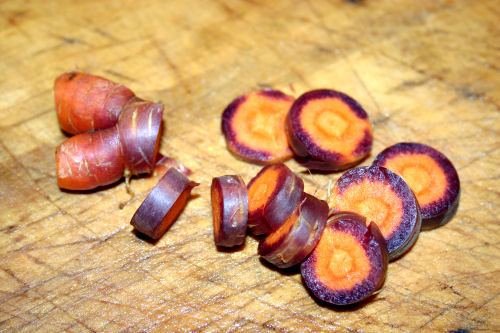Then a few days ago I was eating some yogurt. Raspberry, I think the flavor was. I looked at the ingredients and one of them was "purple carrot concentrate." For the color, I assumed. But this means that there are purple carrots. Who knew?
So it is time to investigate purple foods. I'm not talking about foods that have been dyed purple. I mean the ones that grow that way. Nor am I talking about foods that people like to claim are purple, such as blueberries (blue, hence the name), or beets, which are red. I mean foods that are truly purple.

And I don't mean purple Peeps, either.
(Photo from Calvin College news)
PURPLE FOODS AND NUTRITION
First, I want to give you a few facts about why people are all excited about purple foods these days.
(Image from Scarlet Pixel)
- Purple foods are high in certain types of flavonoids. These compounds have antioxidant properties, meaning they help protect against cellular damage. Generally speaking, the darker the fruit or vegetable, the more flavonoids.
- One type of flavonoid in purple foods has been shown to bolster the health of blood vessels or in other words, improve cardiovascular health.
- Another type of flavonoid present in purple foods is anthocyanins. People who eat foods with lots of anthocyanins typically have a lower rate of cancer.
- Proanthocyanidins, another flavonoid, keep bacteria from clinging to the urinary tract, and so help prevent urinary tract infections.
- I don't want to suggest that if you eat purple foods you will never get heart disease or cancer. It's only been shown that people who have higher levels of these flavonoids in their diet typically are less likely to get these diseases.
- For those of you who like to keep up with the stars, Mariah Carey in 2006 would only eat foods that are purple. She said that plums keep away the wrinkles and stop the aging process. Well, we all know that there is no stopping the aging process. But she believed that strongly in the power of plums.
PURPLE ON THE OUTSIDE
Some foods only have purple skins. These, to my mind, are a less impressive category than the through-and-through purple foods. But we'll get to those next.
Purple-on-the-outside foods do still have those lovely anthocyanins.
Eggplant

Eggplant. Clearly purple only on the outside.
(Photo from mysavvysavings)
- Eggplant is a member of the nightshade family, which makes them related to tomatoes, potatoes, and sweet peppers.
- They grow from hanging from vines, which can grow several feet tall.
- You might also have heard eggplant referred to as aubergine, which is the French word for eggplant.
- People say eggplant has a "pleasantly bitter taste and spongy texture," but I confess I've never found either of those characteristics especially pleasant.
- Eggplant may also have skins that are jade green, purple and green-streaked, orange, or yellow-white.
Plums
- Depending on the variety, the skins might be a reddish purple to a darker, richer purple. But the insides are not purple. Again, it depends on the variety, but the pulp of a plum might be anywhere from yellow to dark red.

These plums are yellow inside.
(Photo from Mix My Granola)
- There are more than 2,000 varieties of plums grown in temperate climates around the world, but only about 20 varieties are grown widely and commercially. Most of those 20 are either Japanese or European.
- Japanese varieties tend to be juicier and their skins tend to have a reddish tinge. The flesh may range from yellow to deep red.
- European varieties are usually darker blue or purple, and the flesh is always yellow. many European plums are grown specifically to be dried into prunes.
- Generally, the darker the skin of the plum, the more bitter the skin will be. The skins of red and yellow plums tend to be sweeter.
- Like eggplant, plums have very high levels of serotonin. Some tests for cancerous tumors are done by screening for serotonin in urine. So if you're about to be tested to see if you have a cancerous tumor, don't eat a lot of plums beforehand because you might get a false positive.
Figs
- Some varieties of figs are purple on the outside. The Mission fig is one such variety. But none are purple on the inside.

(Fig photo from the Joint Problems Blog)
- Figs are extremely sensitive to fluctuations in the weather, they depend on the gall wasp to lay their eggs in a particular fashion and thus pollinate the flowers just so yet without damaging the flower, and the edible variety of fig depends on the inedible variety for pollination so that it will bear fruit. As a result, this crop can be very frustrating for farmers to grow.
- Nonetheless, farmers around the Mediterranean Sea grow 1.5 million tons of figs each year.
- Figs are entirely edible -- skin, seeds, and all.
Concord grapes
- Now you might say that these are absolutely purple throughout. But, I assure you, the innards of Concord grapes are not purple.

Skinned Concord grapes. See? The insides are green!
(Photo from The Persnickety Palate)
- You might also say that the skins look more blue than purple. Well, I'd say, maybe before washing, they have that dusty blue color on the outside.

These Concord grapes happen to be from Michigan
(Photo from Technical Assistance for Farmers)
- But once you smash them up, they make everything purple.

Purple stuff you can make from Concord Grapes.
(Photo from The Kitchn)
- Concord grapes are named after Concord, Massachusetts, where the first variety was grown just down the road from Thoreau's house in 1854. Ephraim Wales Bull developed the seedlings from the seeds of wild, native species that grew in New England.
- One of the quintessential scents of fall, as far as I'm concerned, is the smell of Concord grapes.
Muscadine grapes
- These are perhaps more obviously purple than the Concords.

Muscadine grapes
(Photo from trefoil's Hub Page)
- These, too, are pale green on the inside.
- Muscadine grapes are grown across the Southern US and west into Texas, but they are perhaps best-known in North Carolina. These grapes like it warm and humid.
- They are also known as Scuppernong, which is an older more colloquial name. They were growing wild in North Carolina when Sir Walter Raleigh and other white folks arrived.
Red cabbage
- This one is treading the lines a bit. Sometimes it does look more reddish than purple, as the name suggests. But I wouldn't put it in the Entirely Purple category because it's really only purple on top of each leaf.

This red cabbage definitely looks more purple.
(Photo from Food for Laughter)
- But it is true that if you put red cabbage in cole slaw, for example, it will turn all the cole slaw purple. Or if you've ever had German red cabbage, which my dad dearly loves, that is definitely purple.

German red cabbage. Recipe at Cooks.com.
(Photo from the Book of Yum)
- Cabbages are cruciferous vegetables, a term which refers to their cross-shaped flowers. They are related to cauliflower, broccoli, kale, Brussels sprouts, and collard greens.
Purple asparagus

This variety of purple asparagus, "Purple Passion," is an exceptionally vibrant purple.
(Photo and plants available from Great Lakes Nursery Co.)
- Purple asparagus is sweeter than the green variety because it has a higher sugar content. One grower says her purple asparagus never makes it out of the field to the table because they eat it as soon as it's picked, it's that tasty.
- When cooked, the sweetness in purple asparagus softens to a mild, nutty flavor.
- Purple asparagus also tends to be less stringy than the green varieties.
This variety of purple asparagus, "Purple Haze," isn't as dark on the outside. But, as you can see, it's green in the middle. As are all varieties of purple asparagus.
(Photo from -- how random is this -- the blog of Larry Appleton, the guy who played opposite Balki on Perfect Strangers)
Acai berries
- OK, now we're starting to get exotic.
- These berries only grow in Central and South America, but mainly in Brazil. Chances are, you haven't seen them in your grocery store, but you've seen 9,000 ads about them online.

Here's how acai berries grow
(Photo from Cactus Canyon)

Acai berries up close and personal. Not purple on the inside.
(Photo from My Acai Berry Drink)
- People are making all sorts of health claims for them, or for acai berry juice, that they make you lose weight, that they prevent heart disease and cancer, that they are the fountain of youth, whatever.
- We all know better than to fall for this. Don't let these overblown promises suck you in. Just because you've never heard of Acai berries before doesn't mean they're some secret miracle fruit that will fix every problem with your body and make you live forever. They're a fruit. That's it.
- And, for Pete's sake, you know better than to give anybody your credit card number for a "free trial."
"There's no evidence whatsoever to suggest that acai pills will help shed pounds, flatten tummies, cleanse colon, enhance sexual desire, or perform any of the other commonly advertised functions." -- Center for Science in the Public Interest
- All that said, acai berries are low in sugar as berries go, and the flavor is supposed to taste like a cross between red wine and chocolate.
- Neither the skins nor the seeds are edible. Only the pulp. Which is not purple.
Purple bananas
- No, I'm not making this up. There is one rare variety of banana that grows in China which has purple skins.

These purple bananas were spotted growing near the Xitou Vale in China.
(Photo from Life of Guangzhou)
- I also saw one reference that suggested that purple bananas used to be grown in Cuba but maybe no longer? But maybe they are now sold in Australia? I only saw one mention of this and it wasn't too specific. Anybody out there from Cuba or Australia who can clarify this?
PURPLE THROUGH AND THROUGH
Purple Carrots

(Photo from Makeuptalk)
- It is thought that carrots may have originated as purple and red roots in the region where Afghanistan is now, and after people brought them westward into Europe, perhaps yellow mutant varieties were crossed with other wild varieties to make orange carrots.

Some purple carrots are purple all the way through.
(Photo from the USDA ARS)

But in most pictures of sliced purple carrots, they are orange at the core. These look like they've been dyed purple, but they grew this way.
(Photo from We Are All Mozart)
- Besides purple, there are also red, white, and yellow carrots.
- Some food researchers have tested people's taste preferences and were surprised to discover that the majority of people -- children especially -- actually liked the purple carrots better than the orange ones.
Purple peppers
Depending on the variety, some purple peppers are only purple on the inside, and some are purple all the way through. They're also confusing. Among sweet peppers, here are some of the colorings that can happen:
- Green bell peppers are actually picked too early for the seeds to mature fully. If left to ripen longer on the vine, they will turn purple. The flavor also gets sweeter and less bitter the longer they ripen / the more purple they become. Farmers typically pick them when they're green because doing so makes the plant produce more fruit.
- Some purple bell pepper varieties -- Islander and Secret -- start out purple when they're immature, but they turn green as they ripen, and eventually turn red. These, when still purple, may have that not-yet-ripe bitter flavor.

Purple on the outside, green on the inside. I suspect these might be the purple bell peppers that, if left to ripen longer, might have turned red eventually.
(Grown and photo taken by Leslie at Palazzo Rospo)

With this one I'm really going to bet my money that it's an Islander (lavender) pepper that might have eventually turned red.
(Photo from A Public Healthy Appetite)
- Sweet bell peppers that are truly purple include these varieties:
- Sweet Chocolate
- Lilac
- Chocolate Beauty
- Purple Beauty

This is a Chocolate Beauty bell pepper which starts out green but will ripen to this deep, chocolate purple.
(Photo and plant available from Brewery Creek Garden Center)

Here's a Sweet Chocolate bell pepper, allowed to ripen completely. It's more red on the inside than purple, but it sure isn't green!
(Photo and seeds available from Hawthorn Farm Organic Seeds)
There are also some hot peppers that can be purple.
- Most of the hot ones that are purple only start out that way and as they ripen will turn yellow, orange, and finally red. These are usually quite hot!
- Serrano peppers are hot, and they start out purple, but they stay that way.

Serrano peppers start purple and stay purple when ripe. These are hot freddies!
(Photo from the Tomato Growers Supply Company where you can buy these and other hot pepper plants)
Purple cauliflower

(Creative Commons photo sourced from The Flowering Garden)
- This one sure looks dyed, but it's not. The purple is truly part of the vegetable.

Cauliflower, purple, through and through. Some varieties do have more white in the middle. It also appears that, in the case of some varieties, the purple might spread or darken during the cooking process. This cauliflower has been braised with bread crumbs and capers.
(Photo and recipe from Speedbump kitchen)
- With some varieties, though, the purple does fade during cooking. "Violet Queen," which sounds like it would be the most impressive, is one of the faders. "Graffiti" retains its color much better.
- One cook suggests adding a few tablespoons of lemon juice to help the purple cauliflower stay purple during cooking.
- Cauliflower is related to cabbage (remember, from the red/purple cabbage sub-entry above?)
- Growers in Great Britain and Italy sell something called purple cauliflower, but it's really a type of broccoli.
- Cauliflower -- regardless of its color -- has been shown to help the liver reduce the toxicity of carcinogenic substances, specifically helping to protect against prostate cancer.
Purple potatoes

No doubt about it, purple potatoes are purple all the way through.
(Photo from Eli Cooks)
- Purple potatoes are originally from South America, most commonly, Peru.
- They're somewhat hard to find in the US, but you're more likely to see them in the fall.
- They have a "subtle, nutty flavor."
- You can prepare purple potatoes the same way you would any other potato, although their color stays the most vivid when microwaved.
- The purple potatoes I had, which arrived mashed, admittedly didn't look very palatable. And the flavor was a bit bland. But I think that's a potential downfall with potatoes in general and, in skilled hands with maybe some sour cream or some such deliciousness, they would be just as excellent as any potato.
- Here's a 4.3-star recipe using purple potatoes, with bacon, leeks, and cheese. With side-car ingredients like those, how could you go wrong?
Sources
Eat a Rainbow, part 4, The Diet Channel, December 15, 2006
Linus Pauling Institute, Antioxidant Activities of Flavonoids
Fighting Cancer by the Bramble, Columbus Dispatch, May 22, 2007
Mariah Carey Will Only Eat It If It's Purple, Star Pulse, June 30, 2006
The World's Healthiest Foods, Eggplant
Food Reference.com, Plums
Innvista, plums
Greekshops.com, Special Feature: Sweet Figs
Concord Grape Association, The History of Concord Grapes
Melissa Ray Davis' Hub Page, Muscadines: Native Grapes of the South
California Rare Fruit Growers Fruit Facts, Muscadine Grape
USDA Agricultural Research Service, America's First Grape: The Muscadine
Vegetarians in Paradise, Cabbage Takes a Roller Coaster Ride Through the Centuries
WebMD, Acai Berries and Acai Berry Juice -- What Are the Health Benefits?
Group challenges acai berry weight loss claims, CNN.com, March 23, 2009
Brazilian Acai Berry Antioxidants Absorbed by Human Body, Research Shows, ScienceDaily, October 17, 2008
Euridice Charon Cardona, Yellow Cassavas, Purple Bananas, Humanities Research, vol. 10 no. 3, 2003
World Carrot Museum, History of Carrots
USDA Agricultural Research Service, Carrots with Character
Trustar Healthnotes, Potatoes
The Desert Garden, Back at the Ranch: Purple Cauliflower
The Flowering Garden, Cauliflower
Purdue University Consumer Horticulture, Pick a Peck of Purple Peppers
"Why not a purple pepper?" Sunset, October 1984
Organic Garden, Purple Asparagus
Acai juice really works. Trust me. Now just give me a credit card number...
ReplyDeleteI didn't know about purple carrots either until I found purple carrot juice in the grocery store. My kids love it.
ReplyDeleteI have always loved purple as a color and it's good to know there are so many wonderful foods that use it. www.satisfiedsole.com
ReplyDeleteBlueberries aren't truly blue either. Much like the concord grapes, mash them up and they're very purple. If its not blue-purple, there really aren't any naturally occurring blue foods out there;
ReplyDeleteCheck out colormatters.com/appmatters.html
wow......nice blog,
ReplyDeletepurple is my favorite color....looking food with purple color gives me immense pleasure...
wow......nice blog,
ReplyDeletepurple is my favorite color....looking food with purple color gives me immense pleasure...
Don't forget purple basil! Thanks for the nice page with so much interesting info, I enjoyed it greatly.
ReplyDeleteblackberries- blackcurrants- elderberries -red onion/actually more purpley-certain types of seaweed-radichio is more purple than red as are some beetroots -purple kale
ReplyDelete